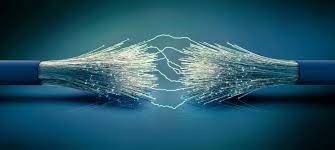Fiber optics are a cutting-edge technology that has revolutionized the way we transmit data, voice, and video signals. These cables are made of incredibly thin strands of glass or plastic, and they use the principle of total internal reflection to transmit data using light signals. This makes fiber optics capable of carrying information over long distances with minimal loss of signal strength.
The Advantages of Fiber Optic Cables
Fiber optic cable offers several significant advantages over traditional copper cables, making them the preferred choice for high-speed data transmission. One of the key advantages is their ability to transmit data at lightning-fast speeds.
Lightning-Fast Speeds for Internet Connectivity
One of the primary reasons why fiber optics are gaining popularity is their unmatched speed. Fiber optics can transmit data at the speed of light, which is significantly faster than the speeds achievable with copper cables. This results in lightning-fast internet connectivity, allowing for quick and seamless online experiences.
With fiber optics, you can enjoy faster download and upload speeds, smoother video streaming, lag-free online gaming, and quicker data transfers. This is especially crucial in today’s digital world, where fast and reliable internet connectivity is essential for various activities, such as remote work, online education, streaming content, and more.
Enhanced Reliability and Signal Quality
Fiber optics are also known for their enhanced reliability and signal quality. Unlike copper cables, which are susceptible to interference from various sources, such as electromagnetic interference (EMI) and radio-frequency interference (RFI), fiber optics are immune to these types of interference. This results in a more stable and consistent internet connection, with minimal disruptions and signal degradation.
Fiber optics are also less prone to attenuation, which is the loss of signal strength over long distances. This means that data can be transmitted over longer distances without the need for repeaters or signal boosters, making fiber optics ideal for long-haul data transmission.
Furthermore, fiber optics are resistant to environmental factors, such as moisture, temperature fluctuations, and corrosion, which can degrade signal quality in copper cables. This makes fiber optics more reliable and durable, ensuring consistent performance even in challenging conditions.
Future-Proofing Your Connectivity
Another significant advantage of fiber optics is that they are future-proof, meaning they are capable of handling increasing data demands in the future. As technology continues to advance and data requirements continue to grow, fiber optics can provide the necessary bandwidth and speeds to meet these demands.
Fiber optics have a much higher bandwidth capacity compared to copper cables, allowing for the transmission of large amounts of data simultaneously. This makes them well-suited for applications that require high bandwidth, such as cloud computing, virtual reality, and the Internet of Things (IoT).
Investing in fiber optics for your internet connectivity is a future-proof solution that can ensure your network can handle the ever-increasing data demands of the modern world without the need for costly upgrades or replacements in the near future.
Wide Range of Applications
Fiber optics are widely used in various industries, including telecommunications, internet service providers (ISPs), data centers, and more. They are increasingly becoming the preferred choice for high-speed internet connectivity due to their numerous advantages over traditional copper cables.
Long-Term Economic Benefits
In addition to their technical advantages, fiber optics also offer economic benefits. While the initial installation costs of fiber optics may be higher than traditional copper cables, the long-term benefits and cost savings outweigh the initial investment. Fiber optics require less maintenance, have longer lifespans, and can result in lower energy consumption, making them a cost-effective solution in the long run.
Getting Started With Fiber Optics Wifi
Fiber optics WiFi, also known as fiber-to-the-home (FTTH) or fiber-to-the-premises (FTTP) internet service, requires professional installation due to the complexity and specialized equipment involved. Contact the internet service providers in your area to check if they offer FTTH or FTTP service and if it is available at your location. ISPs typically have online tools or customer service representatives who can provide information about service availability.
Final Thoughts
In conclusion, fiber optics are revolutionizing the way we transmit data, voice, and video signals, providing lightning-fast speeds for internet connectivity. Their unmatched speed, enhanced reliability, signal quality, and future-proofing capabilities make them the ideal choice for high-speed data transmission.










